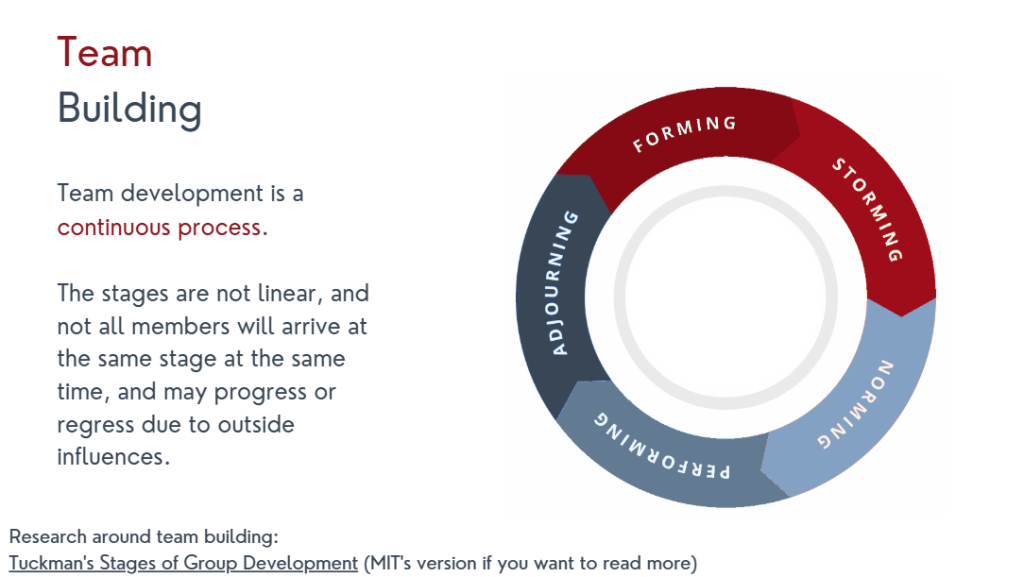1. Understand Team Development Stages and Their Communication Needs
Ever notice how some teams just click effortlessly, accomplishing tasks like a finely tuned orchestra, while others struggle, miscommunicate, and flounder endlessly like a bad sitcom? Good teamwork doesn’t happen by accident—it follows predictable stages of development. Understanding these stages helps you communicate effectively, lead confidently, and ensure your team becomes a powerhouse of productivity.
Welcome to your friendly guide to the classic stages of team development (forming, storming, norming, performing), and how your communication should evolve at each step.

Why Team Development Stages Matter
Teams aren’t static—they naturally evolve. Each stage of team development has unique communication needs. Recognizing these stages ensures you lead effectively, communicate clearly, and provide exactly what your team needs to thrive at each point.
Mastering this helps you:
- Improve team cohesion and collaboration.
- Minimize conflict and misunderstandings.
- Enhance productivity and team effectiveness.
Stage 1: Forming (Getting to Know You)
At first, teams feel a bit like awkward cocktail parties. People are polite, careful, and guarded as they get acquainted and understand expectations.
Communication Needs at the Forming Stage:
- Clearly define roles, goals, and expectations.
- Encourage open, friendly interactions to build initial trust.
- Provide structure, clarity, and plenty of guidance.
Real-world example:
As your team forms, organize an informal introduction session where members briefly share their backgrounds, roles, and personal interests. Explain the team’s purpose and objectives to set expectations from day one.
Stage 2: Storming (Weathering the Storm)
At this stage, differences and conflicts surface. People feel more comfortable voicing opinions—sometimes strongly. Though uncomfortable, storming is normal and necessary for teams to define their working relationships.
Communication Needs at the Storming Stage:
- Open dialogue to express and resolve conflicts constructively.
- Clear leadership to mediate and guide difficult conversations.
- Transparent, honest communication to build trust and resolve tensions.
Real-world example:
If conflicts arise around responsibilities or approaches, address these openly through structured meetings, encouraging respectful, constructive debate. Reinforce that differing opinions help the team strengthen and improve.
Stage 3: Norming (Establishing the Team Rhythm)
Teams begin finding their rhythm, establishing norms, roles, and routines. Trust builds, cooperation improves, and relationships deepen.
Communication Needs at the Norming Stage:
- Reinforce expectations and norms.
- Encourage feedback to strengthen teamwork.
- Provide consistent updates and maintain transparent communication.
Real-world example:
Define routines and regular communication practices, such as weekly team check-ins. Encourage team members to openly share progress, concerns, and suggestions, solidifying team norms and trust.
Stage 4: Performing (Hitting Your Stride)
The performing stage feels like a well-choreographed dance—efficient, productive, and energized. Teams collaborate smoothly, communicate clearly, and produce exceptional results.
Communication Needs at the Performing Stage:
- Maintain streamlined communication channels.
- Trust team members with autonomy, reducing micromanagement.
- Provide regular recognition and support to sustain motivation.
Real-world example:
At this stage, delegate more responsibility, allowing members to collaborate autonomously. Keep meetings concise, focused, and purposeful. Regularly acknowledge team achievements to reinforce motivation and trust.
(Bonus!) Stage 5: Adjourning (Saying Goodbye)
Teams formed for specific projects eventually conclude. The adjourning stage involves closure, reflection, and celebration.
Communication Needs at the Adjourning Stage:
- Acknowledge team accomplishments.
- Reflect openly on lessons learned.
- Provide thoughtful closure and recognition for team contributions.
Real-world example:
Organize a short, informal meeting or event acknowledging everyone’s contributions, celebrating the team’s successes, and openly sharing lessons learned—ending the team experience on a positive, constructive note.
Quick Checklist: Matching Communication to Team Stages
Before your next team interaction, quickly confirm:
Forming: Clearly define roles and goals; encourage introductions.
Storming: Address conflicts openly, mediate constructively.
Norming: Reinforce norms; establish communication routines.
Performing: Trust and delegate; streamline communication.
Adjourning: Celebrate successes; reflect openly on experiences.
Real-World Scenario: Effective Communication Through Team Stages
Imagine you’ve formed a team to launch a product:
Forming:
Start with a kickoff meeting, outlining goals, expectations, and roles, encouraging friendly introductions.
Storming:
If team members clash on strategies, organize open, structured discussions to address conflicts constructively, helping the team find common ground.
Norming:
Establish weekly updates and expectations for communication, reinforcing norms and building a routine.
Performing:
Give team members autonomy, streamline meetings, and consistently recognize achievements.
Adjourning:
Celebrate the successful product launch with an informal event, acknowledging contributions and reflecting on lessons learned for future projects.
This approach ensures clear communication at each team stage, maximizing effectiveness and cohesion.
Final Thoughts: Mastering Team Communication Through Development Stages
Understanding your team’s development stage and adapting your communication style accordingly ensures smooth collaboration, effective teamwork, and exceptional results. Recognize that teams naturally evolve—your communication must evolve with them to ensure clarity, trust, and productivity.
Ready to build even stronger teams by mastering trust, psychological safety, and collaborative decision-making? Excellent—let’s keep going!
